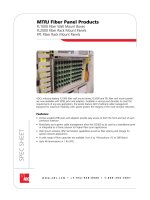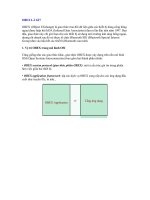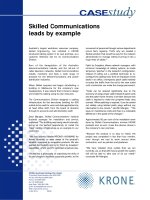Tài liệu Zend Enterprise PHP Patterns pptx
Bạn đang xem bản rút gọn của tài liệu. Xem và tải ngay bản đầy đủ của tài liệu tại đây (4.07 MB, 282 trang )
Coggeshall
Zend Enterprise PHP Patterns
Companion
eBook
Available
spine = 0.625" 280 page count
THE EXPERT’S VOICE® IN PHP
Zend Enterprise
PHP Patterns
John Coggeshall
with Morgan Tocker
Foreword by Andi Gutmans,
Chief Executive Officer, Zend Technologies, Inc.
Performance, architecture, and analysis
of PHP applications
this print for content only—size & color not accurate
BOOKS FOR PROFESSIONALS BY PROFESSIONALS®
Zend Enterprise PHP Patterns
Dear Reader,
As the Senior Architect for Zend Global Services during the first three years of
the group’s existence, I had the opportunity to work with some of the largest PHP
applications on the planet and solve many interesting challenges around perfor-
mance, security, and architecture. At the time there was little in the way of tools
or standards to accomplish these tasks, and the group often had to create the
solutions to our customers’ problems from scratch. The fruit of these efforts has
largely been captured in this book—a compilation of techniques around perfor-
mance, architecture, security, and more taken directly from my experiences.
Thankfully, a lot has changed since 2004, and now extensive tools and tech-
niques exist to solve more effectively many of the issues we struggled with. From
powerful open source frameworks such as Zend Framework to the advanced
tools provided by Zend Studio for Eclipse and Zend Platform, it is now easier to
diagnose and address issues than it has ever been. That said, there are still many
things that require the touch of a knowledgeable engineer, and it is my sincere
hope that you will find this book a useful insight into how these tools, with some
key knowledge, can help you solve many of the common problems faced in
world-class PHP applications today.
The Web and its challenges are always going to be moving targets, changing
nearly daily as technology evolves. The goal of this book is not only to teach you
the practical solutions for some of the common problems for today but also to
give you insight that I hope will help you solve the problems of tomorrow. Enjoy!
Regards,
John Coggeshall
CYAN
MAGENTA
YELLOW
BLACK
PANTONE 123 C
THE APRESS ROADMAP
Zend Enterprise
PHP Patterns
PHP Objects, Patterns, and
Practice, Second Edition
Pro PHP
Practical Web 2.0
Applications with PHP
Beginning PHP 5 and
MySQL, Third Edition
www.apress.com
SOURCE CODE ONLINE
Companion eBook
See last page for details
on $10 eBook version
ISBN 978-1-4302-1974-3
9 781430 219743
54699
US $46.99
Shelve in
PHP
User level:
Intermediate–Advanced
Advanced
www.zendenterprisephp.com
Author of
PHP 5 Unleashed
Download at WoWeBook.Com
Zend Enterprise PHP
Patterns
John Coggeshall with Morgan Tocker
Download at WoWeBook.Com
Zend Enterprise PHP Patterns
Copyright © 2009 by John Coggeshall
All rights reserved. No part of this work may be reproduced or transmitted in any form or by any means,
electronic or mechanical, including photocopying, recording, or by any information storage or retrieval
system, without the prior written permission of the copyright owner and the publisher.
ISBN-13 (pbk): 978-1-4302-1974-3
ISBN-13 (electronic): 978-1-4302-1975-0
Printed and bound in the United States of America 9 8 7 6 5 4 3 2 1
Trademarked names may appear in this book. Rather than use a trademark symbol with every occurrence
of a trademarked name, we use the names only in an editorial fashion and to the benefit of the trademark
owner, with no intention of infringement of the trademark.
Lead Editor: Matt Wade
Technical Reviewer: Kevin Schroeder
Editorial Board: Clay Andres, Steve Anglin, Mark Beckner, Ewan Buckingham, Tony Campbell,
Gary Cornell, Jonathan Gennick, Jonathan Hassell, Michelle Lowman, Matthew Moodie,
Jeffrey Pepper, Frank Pohlmann, Douglas Pundick, Ben Renow-Clarke, Dominic Shakeshaft,
Matt Wade, Tom Welsh
Project Managers: Sofia Marchant and Kylie Johnston
Copy Editor: Hastings Hart
Associate Production Director: Kari Brooks-Copony
Production Editor: April Eddy
Compositor: Lynn L’Heureux
Proofreader: Liz Welch
Indexer: BIM Indexing & Proofreading Services
Artist: April Milne
Cover Designer: Anna Ishchenko
Manufacturing Director: Tom Debolski
Distributed to the book trade worldwide by Springer-Verlag New York, Inc., 233 Spring Street, 6th Floor,
New York, NY 10013. Phone 1-800-SPRINGER, fax 201-348-4505, e-mail kn`ano)ju<olnejcan)o^i*_ki, or
visit dppl6++sss*olnejcankjheja*_ki.
For information on translations, please contact Apress directly at 233 Spring Street, New York, NY 10013.
E-mail ejbk<]lnaoo*_ki or visit dppl6++sss*]lnaoo*_ki.
Apress and friends of ED books may be purchased in bulk for academic, corporate, or promotional use.
eBook versions and licenses are also available for most titles. For more information, reference our Special
Bulk Sales–eBook Licensing web page at dppl6++sss*]lnaoo*_ki+ejbk+^qhgo]hao.
The information in this book is distributed on an “as is” basis, without warranty. Although every precau-
tion has been taken in the preparation of this work, neither the author(s) nor Apress shall have any liability
to any person or entity with respect to any loss or damage caused or alleged to be caused directly or indi-
rectly by the information contained in this work.
The source code for this book is available to readers at dppl6++sss*]lnaoo*_ki.
Download at WoWeBook.Com
To my daughter, Diana Katheryn Coggeshall, who continues to be the single steadfast
reason I have to do more and be more in my life
John Coggeshall
Download at WoWeBook.Com
Download at WoWeBook.Com
v
Contents at a Glance
Foreword xiii
About the Authors xv
About the Technical Reviewer xvii
Acknowledgments xix
Introduction xxi
CHAPTER 1 Introduction to Zend Framework 1
CHAPTER 2 Introduction to Zend Studio for Eclipse 33
CHAPTER 3 Web Application Performance and Analysis 57
CHAPTER 4 Data-Caching Strategies in PHP 71
CHAPTER 5 Asynchronous Operations with PHP 93
CHAPTER 6 Securing Your PHP Applications 123
CHAPTER 7 Monitoring Your Applications 141
CHAPTER 8 Web Services and Zend Framework 167
CHAPTER 9 Production Farms for PHP 193
CHAPTER 10 The MySQL Database 211
INDEX 249
Download at WoWeBook.Com
Download at WoWeBook.Com
vii
Contents
Foreword xiii
About the Authors xv
About the Technical Reviewer xvii
Acknowledgments xix
Introduction xxi
CHAPTER 1 Introduction to Zend Framework 1
Introduction to Zend Framework Library 1
Zend Framework MVC 3
Model, View, and Controller 3
“Hello World” in Zend Framework 9
Zend Framework Request/Response Objects and Error Handling 27
Conclusion 31
CHAPTER 2 Introduction to Zend Studi o for Eclipse 33
Getting Started Zend Studio for Eclipse 33
Creating Projects in Zend Studio for Eclipse 36
Debugging in Zend Studio for Eclipse 38
Profiling in Zend Studio for Eclipse 52
Conclusion 55
CHAPTER 3 Web Applicati on Performance and Analysis 57
Locating the Bottleneck 59
How Are You Bound? 59
Using vmstat 59
Determining Whether You Are CPU-Bound 62
Determining Whether You Are Memory-Bound 63
Determining Whether You Are I/O-Bound 65
Download at WoWeBook.Com
NCONTENTS
viii
Where to Start Looking 66
CPU Bounding Influence 66
Memory Bounding Influence 67
I/O Bounding Influence 67
When the Bottleneck Is a Remote Procedure Call 68
Simulating Load to Identify Future Bottlenecks 68
Conclusion 70
CHAPTER 4 Data-Caching Strategi es in PHP 71
Opcode Caching 71
The PHP Execution Cycle 71
Full-Page Caching 74
What Is Full-Page Caching? 74
Setting Up Full-Page Caching 76
Final Thoughts on Full-Page Caching 79
Semi-Full-Page Caching 79
Programmatic Caching 82
Components of Caching in Zend Framework 82
You Can (Almost) Always Cache Things 83
Knowing Your Cache Effectiveness 85
The Various Zend_Cache Back Ends 85
Conclusion 92
CHAPTER 5 Asynchronous Operations wi th PHP 93
Getting Started with Job Queue 95
Advanced Job Queue Configuration 97
Replacing Job Queue’s PHP with Your Own 97
Modifying the Configuration of Job Queue’s PHP 99
Controlling the Job Queue from the Command Line 99
Using the Job Queue to Execute PHP Scripts 100
Creating Your First Job 100
Searching for Existing Jobs 102
Using Input Parameters in Job Queue Scripts 105
Creating Jobs Programmatically Using the Job Queue API 108
Conclusion 121
Download at WoWeBook.Com
NCONTENTS
ix
CHAPTER 6 Securing Your PHP Appli cations 123
Setting the Context 123
Defining Security 124
Common Threats and Defenses 124
Input Security 125
Securing File Uploads 130
Output Security 135
Conclusion 138
CHAPTER 7 Monitori ng Your Applications 141
Effective Logging Through Zend_Log 141
Getting Started with Zend_Log 142
Advanced Monitoring 149
What Is PHP Intelligence? 149
Getting Started with PHP Intelligence 150
Creating Advanced Monitoring Facilities 155
Customizing Zend_Log Behavior and Integrating 159
with Zend Platform
Logging and Performance
165
Conclusion 166
CHAPTER 8 Web Services and Zend Framework 167
The Multi-Transport Services Architecture Using ZF 167
The Command Pattern 168
The ServiceController Action Controller 176
Creating a Simple Web Service 182
Dealing with SOAP in Zend Framework MVC 184
Consuming Web Services Using Zend Framework 189
Consume REST-Style Services 189
Consuming SOAP Services 191
Conclusion 192
Download at WoWeBook.Com
NCONTENTS
x
CHAPTER 9 Production Farms for PHP 193
General Server Farm Architecture 193
Session Data and Farm Architecture 196
Database Concerns in Farm Architecture 197
MySQL Slave Farm Architecture 198
MySQL Master Farm Architecture 201
Dealing with Serving of Files 203
Asynchronous Operations and the Farm 208
Conclusion 209
CHAPTER 10 The MySQL Database 211
The Storage Engine Concept 211
Optimizing Queries with EXPLAIN 213
Workload-Driven Performance Tuning 220
Read-Heavy Workload 220
Write-Heavy Workload 224
Online Transaction Processing 226
Online Analytical Processing 229
Data Warehouse 230
Optimization Advice That Applies to All Workloads 231
Applications with More Than One Workload 235
Using Appropriate Data Types 235
Estimating Storage Requirements 235
Just Throw Hardware at the Problem 238
CPUs 238
Memory 238
Disks 238
Network 239
Scaling MySQL 239
When Replication Scale Out Works Well 240
When Replication Fails 240
MySQL Sharded Architectures 242
Using MySQL Proxy for Automatic Read/Write Splitting 244
Backing Up MySQL 245
Download at WoWeBook.Com
NCONTENTS
xi
The Rules of Performance Tuning a Database 246
Be Methodical 246
Make Any Benchmarks As Realistic As Possible 246
Realize That Every Setting Has a Range 247
Realize That Things Change over Time 247
Realize That Some Settings Make Trade-offs 247
Realize That Empirical Proof Is the Only True Test 248
Conclusion 248
INDEX 249
Download at WoWeBook.Com
Download at WoWeBook.Com
xiii
Foreword
Seat 5D, Continental Flight 449B, someplace over North America
In the late ’90s, PHP was still referred to mockingly by many computer science gradu-
ates as a “scripting language.” Lack of strict typing was the number one reason it was
not viewed as ready for prime time. At that time most computer science graduates were
developing either in C or C++, or picking up Java, and therefore there was a strong bias in
the IT community. Although PHP grew rapidly during this period and among other things
displaced Perl on the Web, it still was not widely considered an enterprise-ready solution.
During the dot-com boom venture capitalists expected startups to build their solu-
tions on the latest and greatest Oracle/Solaris/WebLogic combo. It was very much a
culture of “Java is the solution. What’s the problem?” Paying ridiculous prices such as
tens of thousands of dollars per CPU did not stop anyone from buying these solutions,
and the majority of projects really weren’t using the enterprise features they paid for. This
was very familiar to the well-known saying, “No one gets fired for buying IBM.”
With the dot-com bust, companies started to realize they needed to get the most
out of their investment. PHP went through a very strong period of growth during those
years, including early penetration within business-critical enterprise applications. The
perception of “scripting languages” changed, and they were even given a new more
professional-sounding name, “dynamic languages.” It was now OK for a computer sci-
ence graduate to add dynamic languages to their toolbox.
Over the past five years PHP adoption within the enterprise has accelerated, and it is
now going mainstream within IT. In addition to the already mentioned reasons for this
change, there were additional factors that drove this change. The ecosystem and the solu-
tions around PHP have matured to make it a strong contender for driving standardization
within corporate IT. With the investments by the likes of IBM, Oracle, Adobe, and Micro-
soft ensuring that PHP runs well with their solutions, there are few solutions that are as
cross-platform and interoperable as PHP.
In addition, application servers, application frameworks, tools, many available
prebuilt applications, and other solutions are now readily available as part of the PHP
ecosystem. Add five million to six million developers to that, and it becomes a very com-
pelling value proposition for enterprises.
With the financial crises that started in 2007 we are seeing the same trends as we did
with the dot-com bust. Companies are looking to do more with less as that is the only way
for them to continue to be competitive and grow. Yet again a perfect setup for yet another
acceleration in PHP adoption, but this time with the full-blown ecosystem.
Download at WoWeBook.Com
NFOREWORD
xiv
Strategic adoption of PHP in mainstream IT continues to accelerate, and there are
few other solutions out there that can compete on the same ease of use, cross-platform
support, huge developer community, large ecosystem, and corporate support.
PHP is in the enterprise because it is faster, cheaper, and I also claim better!
I have known John, the author of this book, for over five years. In fact, first time I
started working with John was when we had a significant enterprise opportunity that we
had to engage with, and I asked John to join that effort. Over the years he has worked with
many enterprises, helping them build business-critical PHP applications. I have no doubt
that you will find this book a valuable resource for building and deploying enterprise-
ready PHP applications.
Andi Gutmans
Cofounder and Chief Executive Officer of Zend Technologies
July 10, 2009
Download at WoWeBook.Com
xv
About the Authors
NJOHN COGGESHALL is CEO of Internet Technology Solutions, a
PHP-focused technology consultancy. The former Senior Architect
of Zend Technologies’ Global Services team, he got started with
PHP in 1997 and is the author of three published books and over
100 articles on PHP technologies with some of the biggest names
in the industry such as Sams Publishing, Apress, and O’Reilly. John
also is an active contributor to the PHP core as the author of the
Tidy extension, a member of the Zend Education Advisory Board,
and a frequent speaker at PHP-related conferences worldwide. His
web site,
dppl6++sss*_kccaod]hh*knc+, is an excellent resource for
any PHP developer, and you can follow him on Twitter by adding
<_kkcha.
NMORGAN TOCKER is a Consultant at Percona, a company that pro-
vides consulting and custom development for MySQL.
Before joining Percona, Morgan worked as a Technical
Instructor for MySQL (and then Sun Microsystems) in Canada,
where he taught courses on high availability, performance tuning,
and database administration. He is a frequent conference speaker
in the United States and Canada.
Morgan has also previously worked as a MySQL Support Engi-
neer and claims that he can look at complex problems and answer
with a bug number, without having to ever look it up.
Download at WoWeBook.Com
Download at WoWeBook.Com
xvii
About the Technical Reviewer
NKEVIN SCHROEDER, Technical Consultant for Zend Technologies, is well versed in technol-
ogies pertinent to small- and large-scale web-application deployments. He has developed
production software using PHP and several other languages and also has extensive expe-
rience in system administration on Linux, Solaris, and Windows. He is the author of The
IBM i Programmer’s Guide to PHP (MC Press, 2009).
Download at WoWeBook.Com
Download at WoWeBook.Com
xix
Acknowledgments
I’d like to give a special thanks to Morgan Tocker, who so willingly agreed to lend his
amazing wealth of MySQL knowledge to this book. Without him the book most certainly
would have suffered.
John Coggeshall
I can remember the day I told my dad I was going to be working remotely for a Swedish
database company called MySQL AB. To him, the idea of someone putting money in my
bank account each month while I sat at home in Australia sounded like a scam. It turned
out to be a big career break.
I would like to acknowledge my former colleagues at the MySQL AB (now Sun Micro-
systems) Support and Training teams. It was through your patience and willingness to
share that I began picking up the pieces to place in this book (with a special thanks to
Tobias Asplund, who provided many of the examples I used).
I would also like to thank Percona, my current employer, for continuing to enhance
MySQL and adding the demanding performance features that escape Sun Microsystems’
eyes. We’d all be at a loss without you.
Morgan Tocker
Download at WoWeBook.Com
Download at WoWeBook.Com
xxi
Introduction
The idea for this book came to me years ago after about a year and a half of working
in the Zend Global Services group. Being “on the front lines” of solving the problems of
some of the most complex PHP application implementations on the planet, it quickly
became clear to me that there was a real need for a text that captures the solutions and
techniques we were discovering from one client to the next. Unfortunately when you’re in
the services business time is scarce, and while I had written the table of contents for the
book, that TOC sat gathering dust in my archives until the day I had the time and energy
to pursue it.
That opportunity came years later, after I resigned my position at Zend to pursue
other challenges. As it turned out, Zend was interested in creating a branded series of
books as part of a series through Apress (“Zend Press”) and was in search of qualified
authors. Suddenly that TOC that had been stagnant for years once again had legs. Of
course it took a few revisions to factor in things that have changed over the years, but ulti-
mately I was surprised to find how many of the solutions we had worked with years ago
still were not only relevant today but also unknown to many PHP developers.
Of all of the books I have worked on over the years, I have enjoyed writing this one
the most. Partly because it’s a bit smaller than my previous works (*grin*), but mostly
because I really feel like the content has so much value that doesn’t get a lot of attention
even today. I hope you enjoy the book as much as I enjoyed writing it! As you get started
with this book, I strongly recommend that you visit the companion web site (
dppl6++sss*
vaj`ajpanlneoaldl*_ki/), where you will find an errata, the VMware virtual machine that is
a complete self-contained environment for the examples and demos found in this book,
as well as other resources you may find useful.
Thank you for purchasing my book! Enjoy!
Who This Book Is For
This book is for intermediate PHP developers who work with large, extremely complex
code bases and have a significant amount of traffic to deal with. It is also for technical
leaders within organizations charged with managing those developers.
Download at WoWeBook.Com
NINTRODUCTION
xxii
How This Book Is Structured
Each chapter in this book for the most part is independent from the next, although they
are all structured in such a way that it can be read cover to cover without issue. This
makes the book not only a great read start to finish but also a great reference guide to
some of the more challenging aspects of PHP application development.
Prerequisites
This book was written against PHP 5.2 and Zend Framework 1.8. That said, the provided
VMware image on the book web site (
dppl6++sss*vaj`ajpanlneoaldl*_ki+) is a fully func-
tional, self-contained environment to work with the code in this book.
Downloading the Code
The source code for this book is available to readers at sss*]lnaoo*_ki in the Down-
loads section of this book’s home page. Please feel free to visit the Apress web site and
download all the code there. You can also find the book’s source code at
dppl6++sss*
vaj`ajpanlneoaldl*_ki+ (recommended).
Contacting the Author
E-mail: fkdj<_kccaod]hh*knc
Web site: dppl6++sss*_kccaod]hh*knc+
Book site: dppl6++sss*vaj`ajpanlneoaldl*_ki+
Twitter: <_kkcha
Download at WoWeBook.Com
1
CHAPTER 1
Introduction to Zend
Framework
When developing an enterprise application in any language, tooling is almost as impor-
tant to you as the way you use the tools. If you look at the success of languages such as
Java you see an entire ecosystem of tools to make the lives of the developers, managers,
and team as a whole better.
When it comes to tooling, the PHP world is no different. While I’ll admit there are
decidedly fewer options available to a PHP development team, those options that do exist
are impressively robust and easy to use. One such category of tools is frameworks that help
ease the pain of development and maintenance of applications for their entire lifetime
while promoting best practices. One such framework is Zend Framework (ZF), where we
will begin our voyage into the development of enterprise-class PHP applications.
Introduction to Zend Framework Library
Zend Framework, while a relatively new framework to the PHP space, has quickly become
the de facto standard of enterprise PHP development. This is due in no small part to Zend
Technologies, which has used its considerable resources to research, develop, and actively
grow the framework into the powerhouse it is today. Philosophically, Zend Framework
is quite different than most other PHP-based frameworks in the sense that your commit-
ment to using the framework is left entirely to you. Where most frameworks force you into
a specific coding practice or impose on you a specific way the framework must be used to
be effective, Zend Framework is based on the notion that each component can be used
completely independently of the rest of the framework. This not only makes each compo-
nent a more interesting piece of technology on its own but also allows you to cherry-pick
those pieces of the framework that solve your development problems without commit-
ting to an entire way of development. In fact, Zend Framework can be used piecemeal in
existing PHP applications to accomplish development tasks as easily as it can be used to
develop incredibly complex applications from the ground up.
Download at WoWeBook.Com









